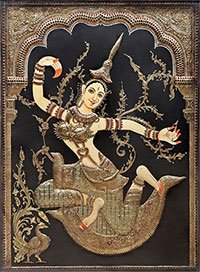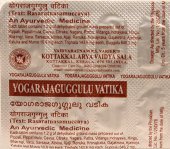Vatika, vaṭikā, Vātīka, Vātika, Vaṭika, Vatikā, Vātikā: 26 definitions
Introduction:
Vatika means something in Buddhism, Pali, Hinduism, Sanskrit, the history of ancient India, Marathi, Hindi. If you want to know the exact meaning, history, etymology or English translation of this term then check out the descriptions on this page. Add your comment or reference to a book if you want to contribute to this summary article.
In Hinduism
Ayurveda (science of life)
Dietetics and Culinary Art (such as household cooking)
Source: Shodhganga: Dietetics and culinary art in ancient and medieval IndiaVaṭikā (वटिका) refers to a type of food preparation with pulses, according to the Mānasollāsa chapter III, and is commonly found in literature dealing with the topics of dietetics and culinary art, also known as Pākaśāstra or Pākakalā.—Mānasollāsa describes many pulse preparations like vidalapāka, iḍarikā, ghārikā, vaṭikā, kaṭakarna, pūrikā, veṣṭikā and dośaka in its third chapter.
Unclassified Ayurveda definitions
Source: Wisdom Library: Āyurveda and botanyVātika (वातिक) is a Sanskrit word referring to a classification of human constitution (prakṛti) where Vāta-doṣa has its dominance. The word is used throughout Ayurvedic (India medicine) literature such as the Caraka-saṃhitā and the Suśruta-saṃhitā. A skilled physician should monitor the constitution of a patient during treatment with medicines and prescribing his diet. Vāta represents the “airy” element of the human body.
Source: Google Books: Essentials of AyurvedaThe person of Vātika constitution (vāta-prakṛti) is averse to cold, inclined to stealing, loves music, has hands and feet cracked, hairs, nails, etc. rough, is impatient and unstable, lean and thin, ungrateful, vociferous, with quick movements, loitering, unsteady in social relations and has quivering eyes.
Source: archive.org: Sushruta samhita, Volume IVātīka (वातीक)—Sanskrit word for a bird. This animal is from the group called Viṣkira (which scatter). Viṣkira itself is a sub-group of the group of animals known as Jāṅghala (living in high ground and in a jungle).

Āyurveda (आयुर्वेद, ayurveda) is a branch of Indian science dealing with medicine, herbalism, taxology, anatomy, surgery, alchemy and related topics. Traditional practice of Āyurveda in ancient India dates back to at least the first millenium BC. Literature is commonly written in Sanskrit using various poetic metres.
Purana and Itihasa (epic history)
Source: archive.org: Puranic EncyclopediaVātika (वातिक).—A warrior of Subrahmaṇya. (Mahābhārata Śalya Parva, Chapter 45, Stanza 67).
Source: Cologne Digital Sanskrit Dictionaries: The Purana IndexVātika (वातिक).—Śyāma Parāśara.*
- * Matsya-purāṇa 201. 37.
Vātika (वातिक) is a name mentioned in the Mahābhārata (cf. IX.44.62) and represents one of the many proper names used for people and places. Note: The Mahābhārata (mentioning Vātika) is a Sanskrit epic poem consisting of 100,000 ślokas (metrical verses) and is over 2000 years old.

The Purana (पुराण, purāṇas) refers to Sanskrit literature preserving ancient India’s vast cultural history, including historical legends, religious ceremonies, various arts and sciences. The eighteen mahapuranas total over 400,000 shlokas (metrical couplets) and date to at least several centuries BCE.
Shaktism (Shakta philosophy)
Source: Brill: Śaivism and the Tantric Traditions (shaktism)Vāṭikā (वाटिका) refers to “groves (of trees)”, according to the King Vatsarāja’s Pūjāstuti called the Kāmasiddhistuti (also Vāmakeśvarīstuti), guiding one through the worship of the Goddess Nityā.—Accordingly, “[...] O goddess! You enter the heart of a man whose mind is composed. Sweet ballads of your renown, O Gaurī, the Vidyādharas sing in the groves (vāṭikā) of Haricandana trees that emit the sweet fragrance of liquor on the banks of the heavenly river”.

Shakta (शाक्त, śākta) or Shaktism (śāktism) represents a tradition of Hinduism where the Goddess (Devi) is revered and worshipped. Shakta literature includes a range of scriptures, including various Agamas and Tantras, although its roots may be traced back to the Vedas.
Sports, Arts and Entertainment (wordly enjoyments)
Source: archive.org: Syainika Sastra of Rudradeva with English Translation (art)Vaṭikā (वटिका) refers to a “medicinal pill” (used in the treatment of Hawks), according to the Śyainika-śāstra: a Sanskrit treatise dealing with the divisions and benefits of Hunting and Hawking, written by Rājā Rudradeva (or Candradeva) in possibly the 13th century.—Accordingly, [while discussing the treatment of hawks]: “If a white spot forms on the eyes owing to heat, smoke or some kind of hurt, [...] Or a pill (vaṭikā) made of the following drugs in equal quantities, soaked in goat’s urine and dried in the shade, may be given; turmeric, leaves of nīm/neem, pepper, yellow myrobalan, long pepper, Cyperus rotundus, and viḍaṅga. It should be administered with honey and goat’s milk in the case of the red kind of birds. This (vaṭikā) pill destroys the spot, as if the pill had been made by Rudra”.

This section covers the skills and profiencies of the Kalas (“performing arts”) and Shastras (“sciences”) involving ancient Indian traditions of sports, games, arts, entertainment, love-making and other means of wordly enjoyments. Traditionally these topics were dealt with in Sanskrit treatises explaing the philosophy and the justification of enjoying the pleasures of the senses.
In Buddhism
Tibetan Buddhism (Vajrayana or tantric Buddhism)
Source: Wisdom Library: Tibetan BuddhismVātikā (वातिका) refers to a group of deities summoned by the Yamāntaka-mantra and mentioned as attending the teachings in the 6th century Mañjuśrīmūlakalpa: one of the largest Kriyā Tantras devoted to Mañjuśrī (the Bodhisattva of wisdom) representing an encyclopedia of knowledge primarily concerned with ritualistic elements in Buddhism. The teachings in this text originate from Mañjuśrī and were taught to and by Buddha Śākyamuni in the presence of a large audience (including Vātikā).

Tibetan Buddhism includes schools such as Nyingma, Kadampa, Kagyu and Gelug. Their primary canon of literature is divided in two broad categories: The Kangyur, which consists of Buddha’s words, and the Tengyur, which includes commentaries from various sources. Esotericism and tantra techniques (vajrayāna) are collected indepently.
India history and geography
Source: Cologne Digital Sanskrit Dictionaries: Indian Epigraphical GlossaryVāṭikā.—(EI 15; SITI), same as nilam or veḻi, defined in the Mayamata as 5120 square daṇḍas, the length of the daṇḍa being 4 cubits; 4. 48 acres. (EI 30), a land measure equal to twenty māṇas in Orissa; same as vāṭi, vāṭī; equal to 20 acres. (EI 27), a hamlet. Note: vāṭikā is defined in the “Indian epigraphical glossary” as it can be found on ancient inscriptions commonly written in Sanskrit, Prakrit or Dravidian languages.

The history of India traces the identification of countries, villages, towns and other regions of India, as well as mythology, zoology, royal dynasties, rulers, tribes, local festivities and traditions and regional languages. Ancient India enjoyed religious freedom and encourages the path of Dharma, a concept common to Buddhism, Hinduism, and Jainism.
Languages of India and abroad
Pali-English dictionary
Source: BuddhaSasana: Concise Pali-English Dictionaryvatika : (adj.) (in cpds.) having the habit of; acting like. || vātika (adj.), caused by the wind humour. vatikā (f.) a fence.
Source: Sutta: The Pali Text Society's Pali-English DictionaryVatika, (adj.) (-°) (vata2+ika) having the habit (of), acting like M. I, 387 (kukkura°). (Page 597)
— or —
Vātika, (adj.) (fr. vāta 2, cp. *Sk. vātakin Halāyudha II. 451) connected with the winds (humours) of the body, having bad circulation, suffering from internal trouble, rheumatic (?) Miln. 135, 298. (Page 608)
— or —
Vatikā, (f.) (fr. vati1) a fence SnA 148 (kaṇṭaka° & rukkha°). (Page 597)

Pali is the language of the Tipiṭaka, which is the sacred canon of Theravāda Buddhism and contains much of the Buddha’s speech. Closeley related to Sanskrit, both languages are used interchangeably between religions.
Marathi-English dictionary
Source: DDSA: The Molesworth Marathi and English Dictionaryvaṭikā (वटिका).—f (S) vaṭī f (S) A plat or bed (of a garden &c.) 2 A pill. 3 A cake or pat; a small flattish lump (of dough or bread, of butter, soap, kneaded cowdung &c.)
--- OR ---
vāṭikā (वाटिका) [or वाटी, vāṭī].—f (S) A garden, orchard &c., a piece of ground set with vegetables, flowers, or fruit-trees. Generally in comp. as puṣpavāṭikā A flower-garden; vṛkṣavāṭikā A plantation of trees, an orchard, a grove; ikṣuvāṭikā, tālavāṭikā &c.
--- OR ---
vātika (वातिक).—a S Relating to the humor vāta or Wind in the system.
Source: DDSA: The Aryabhusan school dictionary, Marathi-Englishvaṭikā (वटिका).—f A bed or plat. A pill. A cake or pat.
--- OR ---
vāṭikā (वाटिका).—f A garden, orchard.
Marathi is an Indo-European language having over 70 million native speakers people in (predominantly) Maharashtra India. Marathi, like many other Indo-Aryan languages, evolved from early forms of Prakrit, which itself is a subset of Sanskrit, one of the most ancient languages of the world.
Sanskrit dictionary
Source: DDSA: The practical Sanskrit-English dictionaryVaṭika (वटिक).—A pawn at chess.
Derivable forms: vaṭikaḥ (वटिकः).
--- OR ---
Vaṭikā (वटिका).—[vaṭ-in Uṇādi-sūtra 4.128]
1) A pill.
2) A chessman.
3) A kind of cake or bread (Mar. āṃboḷī) made of rice and Māṣa.
--- OR ---
Vāṭikā (वाटिका).—
1) The site of a house.
2) An orchard, a garden; अये दक्षिणेन वृक्षवाटिकामालाप इव श्रूयते (aye dakṣiṇena vṛkṣavāṭikāmālāpa iva śrūyate) Ś1; so पुष्प°, अशोक° (puṣpa°, aśoka°) &c.
3) A hut.
See also (synonyms): vāṭaka.
--- OR ---
Vātika (वातिक).—a. (-kī f.) [वातादागतः ठक् (vātādāgataḥ ṭhak)]
1) Stormy, windy.
2) Gouty, rheumatic.
3) Mad.
-kaḥ 1 Fever caused by a vitiated state of the wind.
2) A person affected by flatulence.
3) A flatterer; एवं तत्राब्रुवन् केचिद्वातिकास्तं जने- श्वरम् (evaṃ tatrābruvan kecidvātikāstaṃ jane- śvaram) Mahābhārata (Bombay) 3.257.4.
4) A class of deities (devayoniviśeṣa); वातिकाश्चारणा ये तु दृष्ट्वा ते हर्षमागताः (vātikāścāraṇā ye tu dṛṣṭvā te harṣamāgatāḥ) Mahābhārata (Bombay) 9.55.14 (com. vātikāḥ vātena saha gacchanti ākāśacāriṇaḥ).
5) A juggler.
6) A dealer in antidotes.
7) The Chātaka bird.
Source: Cologne Digital Sanskrit Dictionaries: Edgerton Buddhist Hybrid Sanskrit DictionaryVaṭika (वटिक).—v.l. for dhaṭika, q.v.
Source: Cologne Digital Sanskrit Dictionaries: Shabda-Sagara Sanskrit-English DictionaryVaṭika (वटिक).—m.
(-kaḥ) A pawn at chess. f.
(-kā) 1. A pill. 2. A chessman.
--- OR ---
Vāṭikā (वाटिका).—f.
(-kā) 1. The site of a house. 2. A plant, (Sida cordifolia.) 3. A garden, an orchard. E. kan added to vāṭī .
--- OR ---
Vātika (वातिक).—mfn.
(-kaḥ-kī-kaṃ) 1. Windy, stormy. 2. Rheumatic. 3. Produced by or proceeding from wind, (disease, &c.) m.
(-kaḥ) Fever or inflammation ascribed to a vitiated state of the aerial humour. E. vāta wind, &c., ṭhak aff.
Source: Cologne Digital Sanskrit Dictionaries: Benfey Sanskrit-English DictionaryVāṭikā (वाटिका).—i. e. vāṭī + ka, f. 1. The site of a house. 2. A garden, [Pañcatantra] 221, 10.
--- OR ---
Vātika (वातिक).—i. e. vāta + ika, I. adj. 1. Produced by wind. 2. Windy. 3. Rheumatic. 4. Mad, Sāh. Darp. 286, 14. Ii. n. Fever or inflammation, ascribed to a vitiated state of the aerial humour.
Source: Cologne Digital Sanskrit Dictionaries: Cappeller Sanskrit-English DictionaryVātika (वातिक).—[masculine] wind-maker, i.e. braggart, boaster.
Source: Cologne Digital Sanskrit Dictionaries: Monier-Williams Sanskrit-English Dictionary1) Vaṭikā (वटिका):—[from vaṭaka > vaṭ] a f. idem, [Pañcatantra] ([Bombay edition]), [Lalita-vistara]
2) [v.s. ...] a pawn (at chess), [cf. Lexicographers, esp. such as amarasiṃha, halāyudha, hemacandra, etc.]
3) Vaṭika (वटिक):—[from vaṭ] m. a pawn (at chess), [cf. Lexicographers, esp. such as amarasiṃha, halāyudha, hemacandra, etc.]
4) Vaṭikā (वटिका):—[from vaṭika > vaṭ] b f. See under vaṭaka.
5) Vātika (वातिक):—[from vā] mf(ī)n. windy, stormy, [cf. Lexicographers, esp. such as amarasiṃha, halāyudha, hemacandra, etc.]
6) [v.s. ...] affected by wind-disease, rheumatic, [cf. Lexicographers, esp. such as amarasiṃha, halāyudha, hemacandra, etc.]
7) [v.s. ...] exciting or allaying wind (in the body), [Patañjali]
8) [v.s. ...] produced by or proceeding from disorder of the wind, [Suśruta]
9) [v.s. ...] mad, [Monier-Williams’ Sanskrit-English Dictionary]
10) [v.s. ...] m. a man of mere words, noisy talker, flatterer, [Mahābhārata]
11) [v.s. ...] a juggler or conjurer, [Mahābhārata; Harṣacarita]
12) [v.s. ...] a person who cures poison, dealer in antidotes, [cf. Lexicographers, esp. such as amarasiṃha, halāyudha, hemacandra, etc.]
13) [v.s. ...] the bird Cātaka, [Sāhitya-darpaṇa] (cf. vātīka)
14) [v.s. ...] Name of an attendant of Skanda, [Mahābhārata]
15) Vātīka (वातीक):—[from vā] m. a kind of bird, [Caraka] (cf. vātika).
16) Vāṭikā (वाटिका):—[from vāṭaka > vāṭa] f. idem, [Kāvya literature; Kathāsaritsāgara; Pañcadaṇḍacchattra-prabandha]
17) [v.s. ...] the site of a house, [cf. Lexicographers, esp. such as amarasiṃha, halāyudha, hemacandra, etc.]
18) [v.s. ...] a hut, [cf. Lexicographers, esp. such as amarasiṃha, halāyudha, hemacandra, etc.]
Source: Cologne Digital Sanskrit Dictionaries: Yates Sanskrit-English Dictionary1) Vāṭikā (वाटिका):—(kā) 1. f. The site of a house; Sida cordifolia; a garden.
2) Vātika (वातिक):—[(kaḥ-kī-kaṃ) a.] Windy; rheumatic. n. Fever. inflammation.
Source: DDSA: Paia-sadda-mahannavo; a comprehensive Prakrit Hindi dictionary (S)Vātika (वातिक) in the Sanskrit language is related to the Prakrit words: Vāia, Vāḍiā.
[Sanskrit to German]
Sanskrit, also spelled संस्कृतम् (saṃskṛtam), is an ancient language of India commonly seen as the grandmother of the Indo-European language family (even English!). Closely allied with Prakrit and Pali, Sanskrit is more exhaustive in both grammar and terms and has the most extensive collection of literature in the world, greatly surpassing its sister-languages Greek and Latin.
Hindi dictionary
Source: DDSA: A practical Hindi-English dictionary1) Vaṭikā (वटिका):—(nf) a pill, tablet; ball, small lump or round mass.
2) Vāṭikā (वाटिका):—(nf) a small garden.
...
Kannada-English dictionary
Source: Alar: Kannada-English corpusVātika (ವಾತಿಕ):—[noun] a man who or animal which is easily affected by the windy humour.
Kannada is a Dravidian language (as opposed to the Indo-European language family) mainly spoken in the southwestern region of India.
See also (Relevant definitions)
Starts with: Vatikai, Vatikakhanda, Vatikal, Vatikam, Vatikan, Vatikanci, Vatikapindaka, Vatikara, Vatikashanda, Vatikattu, Vatikkayiru.
Ends with (+49): Abhravatika, Aksharavatika, Amlavatika, Amravatika, Anguttaranavatika, Avatika, Bhaddavati, Bhukshiravatika, Danaveyyavatika, Dviravatika, Ekatyashashvatika, Gaganavatika, Gandhavatika, Grihavatika, Grihavrikshavatika, Haimavatika, Hingushivatika, Ikshuvatika, Jirnavatika, Kankayanavatika.
Full-text (+78): Vataka, Vrikshavatika, Jirnavatika, Marttikavataka, Grihavatika, Ikshuvatika, Kasundivatika, Vatin, Shakavata, Amlavatika, Pushpavatika, Sacivatika, Phalguvatika, Shashivatika, Griharama, Vadika, Vatikapindaka, Vatikashanda, Vatikakhanda, Vati.
Relevant text
Search found 21 books and stories containing Vatika, Vaṭikā, Vātīka, Vātika, Vaṭika, Vatikā, Vāṭikā, Vātikā; (plurals include: Vatikas, Vaṭikās, Vātīkas, Vātikas, Vaṭikas, Vatikās, Vāṭikās, Vātikās). You can also click to the full overview containing English textual excerpts. Below are direct links for the most relevant articles:
The Skanda Purana (by G. V. Tagare)
Chapter 148 - Greatness of Vaṭikeśvara (Vaṭika-īśvara) < [Section 1 - Tīrtha-māhātmya]
Chapter 147 - Dialogue between Vyāsa and Śuka < [Section 1 - Tīrtha-māhātmya]
Chapter 23 - Lohāsura Devastates Dharmāraṇya < [Section 2 - Dharmāraṇya-khaṇḍa]
Atharvaveda and Charaka Samhita (by Laxmi Maji)
Apasmāra (epilepsy) according to Caraka < [Chapter 4 - Diseases and Remedial measures (described in Caraka-saṃhitā)]
Atisāra (diarrhea) according to Caraka < [Chapter 4 - Diseases and Remedial measures (described in Caraka-saṃhitā)]
Tṛṣṇā (morbid thirst) according to Caraka < [Chapter 4 - Diseases and Remedial measures (described in Caraka-saṃhitā)]
Garga Samhita (English) (by Danavir Goswami)
Verse 4.19.64 < [Chapter 19 - A Thousand Names of Srī Yamunā]
Historical Elements in the Matsya Purana (by Chaitali Kadia)
Lineages of Parāśara < [Chapter 6 - Human history in the Matsya-Purāṇa]
List of Mahabharata people and places (by Laxman Burdak)
Bhajana-Rahasya (by Srila Bhaktivinoda Thakura Mahasaya)
Text 12 < [Chapter 8 - Aṣṭama-yāma-sādhana (Rātri-līlā–prema-bhajana sambhoga)]
Related products
(+1 more products available)





